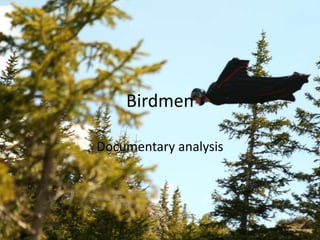Ethans media birdmen
- 2. Type of documentary âĒ Reincarnated it was a mixed documentary. It is a mixed documentary as it contains, archive footage and voice overs
- 3. Narrative structure âĒ The beginning of the documentary establishes the history of wing suit flying, it shows the early renegades of the sport in the 1940s it then shows how the sport became more popular in the 1990âs as Patrick DeGayardon commercialist the sport. This is all set out like a time line and is accompanied by a voice over giving the viewers more information on the sport. The documentary then changes and starts to show modern wing suiters, focusing on four american professionals and how they are changing the sport and bringing it more and more into the public eye by making dives more risky and flying in more amazing remote locations. It then goes onto emphasize the risk of the sport by telling the story of Patrick DeGayardonâs death in 1998 due to him trying to modify his wingsuit and falling to his death as a result of it. The end is about the future of the sport and how it is becoming ever more popular and how the sport is changing.
- 4. Camera work âĒ A lot of the filming is shot on GoProâs, these are action cameras attached to the top of the wing suiters helmets. This shows the viewers exactly what they can see and results in some amazing shots of the locations and scenery. There is also a lot of establishing shots of locations where the wingsuiters jump from, this really brings the viewer into the documentary
- 5. Mise En Scene âĒ All of the interviews are shot outside with a scenery or skyline behind them. nothing is shot inside. This emphasizes the freedom of flight and how its so open. This makes the viewer also feel the freedom of flight.
- 6. Sound âĒ There is a male voice over at the start of the the documentary establishing the history of the sport, and is then dotted about throughout the documentary. There is a lot of silence before the jumps and there is only the diegetic sound of wind this builds up tension and keeps the audience on edge.
- 7. Editing âĒ There is a lot of long, drawn out shots before the wingsuiters jump and during the actual jump this draws in focus on the jump more and emphasizes the glide of the jump.
- 8. Archive footage âĒ Archive footage is used a lot in birdmen. Archive footage of the first Birdmen in the 1930s and shows how they advanced. There is also Archive footage of interviews with Patrick DeGayardon before his death.








